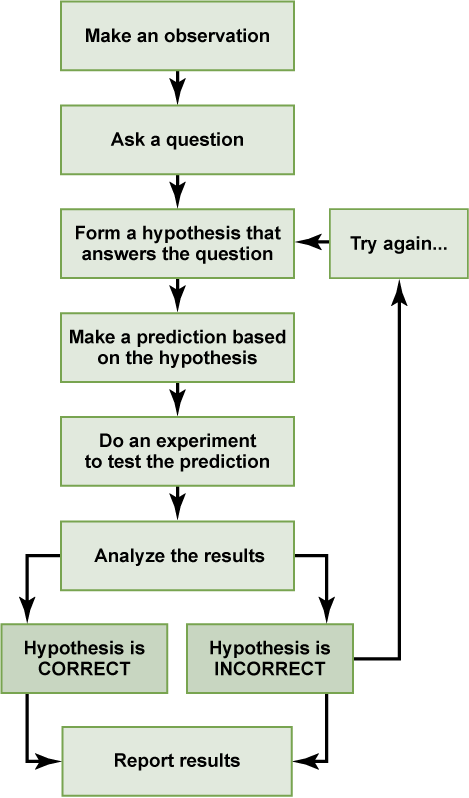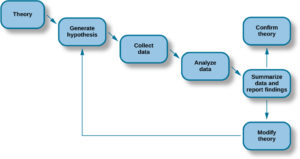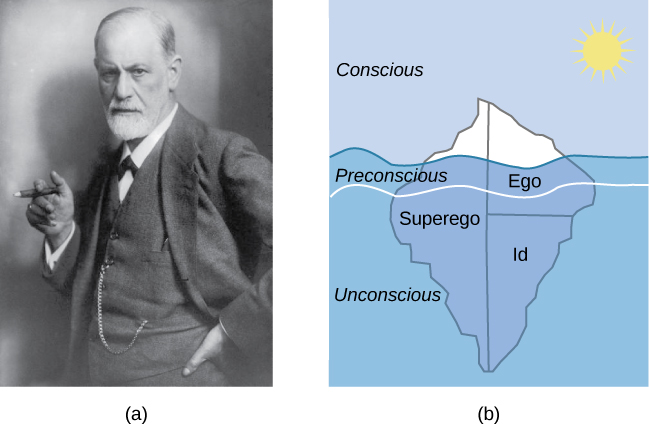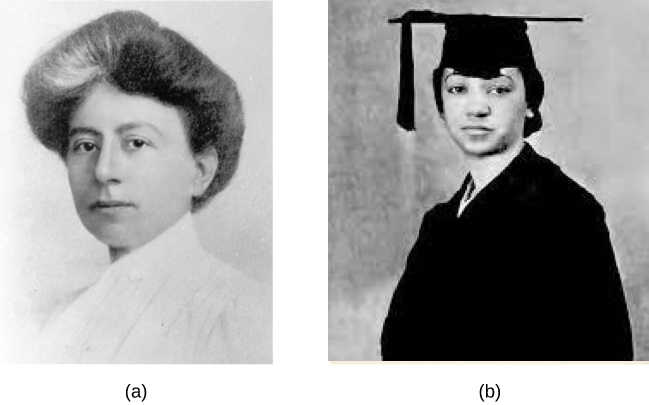Learning Objectives
- Explain the steps of the scientific method
- Differentiate between theories and hypotheses

Figure 1. Some of our ancestors, across the world and over the centuries, believed that trephination—the practice of making a hole in the skull, as shown here—allowed evil spirits to leave the body, thus curing mental illness and other disorders. (credit: “taiproject”/Flickr)
The goal of all scientists is to better understand the world around them. Psychologists focus their attention on understanding behavior, as well as the cognitive (mental) and physiological (body) processes that underlie behavior. In contrast to other methods that people use to understand the behavior of others, such as intuition and personal experience, the hallmark of scientific research is that there is evidence to support a claim. Scientific knowledge is empirical: It is grounded in objective, tangible evidence that can be observed time and time again, regardless of who is observing.
While behavior is observable, the mind is not. If someone is crying, we can see the behavior. However, the reason for the behavior is more difficult to determine. Is the person crying due to being sad, in pain, or happy? Sometimes we can learn the reason for someone’s behavior by simply asking a question, like “Why are you crying?” However, there are situations in which an individual is either uncomfortable or unwilling to answer the question honestly, or is incapable of answering. For example, infants would not be able to explain why they are crying. In such circumstances, the psychologist must be creative in finding ways to better understand behavior. This module explores how scientific knowledge is generated, and how important that knowledge is in forming decisions in our personal lives and in the public domain.
Try It
Process of Scientific Research

Figure 2. The scientific method is a process for gathering data and processing information. It provides well-defined steps to standardize how scientific knowledge is gathered through a logical, rational problem-solving method.
Scientific knowledge is advanced through a process known as the scientific method. Basically, ideas (in the form of theories and hypotheses) are tested against the real world (in the form of empirical observations), and those empirical observations lead to more ideas that are tested against the real world, and so on.
The basic steps in the scientific method are:
- Observe a natural phenomenon and define a question about it
- Make a hypothesis, or potential solution to the question
- Test the hypothesis
- If the hypothesis is true, find more evidence or find counter-evidence
- If the hypothesis is false, create a new hypothesis or try again
- Draw conclusions and repeat–the scientific method is never-ending, and no result is ever considered perfect
In order to ask an important question that may improve our understanding of the world, a researcher must first observe natural phenomena. By making observations, a researcher can define a useful question. After finding a question to answer, the researcher can then make a prediction (a hypothesis) about what they think the answer will be. This prediction is usually a statement about the relationship between two or more variables. After making a hypothesis, the researcher will then design an experiment to test their hypothesis and evaluate the data gathered. These data will either support or refute the hypothesis. Based on the conclusions drawn from the data, the researcher will then find more evidence to support the hypothesis, look for counter-evidence to further strengthen the hypothesis, revise the hypothesis and create a new experiment, or continue to incorporate the information gathered to answer the research question.
Basic Principles of the Scientific Method
Two key concepts in the scientific approach are theory and hypothesis. A theory is a well-developed set of ideas that propose an explanation for observed phenomena that can be used to make predictions about future observations. A hypothesis is a testable prediction that is arrived at logically from a theory. It is often worded as an if-then statement (e.g., if I study all night, I will get a passing grade on the test). The hypothesis is extremely important because it bridges the gap between the realm of ideas and the real world. As specific hypotheses are tested, theories are modified and refined to reflect and incorporate the result of these tests.
Try It

Figure 3. The scientific method involves deriving hypotheses from theories and then testing those hypotheses. If the results are consistent with the theory, then the theory is supported. If the results are not consistent, then the theory should be modified and new hypotheses will be generated.
Other key components in following the scientific method include verifiability, predictability, falsifiability, and fairness. Verifiability means that an experiment must be replicable by another researcher. To achieve verifiability, researchers must make sure to document their methods and clearly explain how their experiment is structured and why it produces certain results.
Predictability in a scientific theory implies that the theory should enable us to make predictions about future events. The precision of these predictions is a measure of the strength of the theory.
Falsifiability refers to whether a hypothesis can be disproved. For a hypothesis to be falsifiable, it must be logically possible to make an observation or do a physical experiment that would show that there is no support for the hypothesis. Even when a hypothesis cannot be shown to be false, that does not necessarily mean it is not valid. Future testing may disprove the hypothesis. This does not mean that a hypothesis has to be shown to be false, just that it can be tested.
To determine whether a hypothesis is supported or not supported, psychological researchers must conduct hypothesis testing using statistics. Hypothesis testing is a type of statistics that determines the probability of a hypothesis being true or false. If hypothesis testing reveals that results were “statistically significant,” this means that there was support for the hypothesis and that the researchers can be reasonably confident that their result was not due to random chance. If the results are not statistically significant, this means that the researchers’ hypothesis was not supported.
Fairness implies that all data must be considered when evaluating a hypothesis. A researcher cannot pick and choose what data to keep and what to discard or focus specifically on data that support or do not support a particular hypothesis. All data must be accounted for, even if they invalidate the hypothesis.
Try It
Applying the Scientific Method
To see how this process works, let’s consider a specific theory and a hypothesis that might be generated from that theory. As you’ll learn in a later module, the James-Lange theory of emotion asserts that emotional experience relies on the physiological arousal associated with the emotional state. If you walked out of your home and discovered a very aggressive snake waiting on your doorstep, your heart would begin to race and your stomach churn. According to the James-Lange theory, these physiological changes would result in your feeling of fear. A hypothesis that could be derived from this theory might be that a person who is unaware of the physiological arousal that the sight of the snake elicits will not feel fear.
Remember that a good scientific hypothesis is falsifiable, or capable of being shown to be incorrect. Recall from the introductory module that Sigmund Freud had lots of interesting ideas to explain various human behaviors. However, a major criticism of Freud’s theories is that many of his ideas are not falsifiable; for example, it is impossible to imagine empirical observations that would disprove the existence of the id, the ego, and the superego—the three elements of personality described in Freud’s theories. Despite this, Freud’s theories are widely taught in introductory psychology texts because of their historical significance for personality psychology and psychotherapy, and these remain the root of all modern forms of therapy.

Figure 4. Many of the specifics of (a) Freud’s theories, such as (b) his division of the mind into id, ego, and superego, have fallen out of favor in recent decades because they are not falsifiable. In broader strokes, his views set the stage for much of psychological thinking today, such as the unconscious nature of the majority of psychological processes.
In contrast, the James-Lange theory does generate falsifiable hypotheses, such as the one described above. Some individuals who suffer significant injuries to their spinal columns are unable to feel the bodily changes that often accompany emotional experiences. Therefore, we could test the hypothesis by determining how emotional experiences differ between individuals who have the ability to detect these changes in their physiological arousal and those who do not. In fact, this research has been conducted and while the emotional experiences of people deprived of an awareness of their physiological arousal may be less intense, they still experience emotion (Chwalisz, Diener, & Gallagher, 1988).
Try It
Link to Learning
Want to participate in a study? Visit this Psychological Research on the Net website and click on a link that sounds interesting to you in order to participate in online research.
Why the Scientific Method Is Important for Psychology
The use of the scientific method is one of the main features that separates modern psychology from earlier philosophical inquiries about the mind. Compared to chemistry, physics, and other “natural sciences,” psychology has long been considered one of the “social sciences” because of the subjective nature of the things it seeks to study. Many of the concepts that psychologists are interested in—such as aspects of the human mind, behavior, and emotions—are subjective and cannot be directly measured. Psychologists often rely instead on behavioral observations and self-reported data, which are considered by some to be illegitimate or lacking in methodological rigor. Applying the scientific method to psychology, therefore, helps to standardize the approach to understanding its very different types of information.
The scientific method allows psychological data to be replicated and confirmed in many instances, under different circumstances, and by a variety of researchers. Through replication of experiments, new generations of psychologists can reduce errors and broaden the applicability of theories. It also allows theories to be tested and validated instead of simply being conjectures that could never be verified or falsified. All of this allows psychologists to gain a stronger understanding of how the human mind works.
Scientific articles published in journals and psychology papers written in the style of the American Psychological Association (i.e., in “APA style”) are structured around the scientific method. These papers include an introduction, which introduces the background information and outlines the hypotheses; a methods section, which outlines the specifics of how the experiment was conducted to test the hypothesis; a results section, which includes the statistics that tested the hypothesis and state whether it was supported or not supported, and a discussion and conclusion, which state the implications of finding support for, or no support for, the hypothesis. Writing articles and papers that adhere to the scientific method makes it easy for future researchers to repeat the study and attempt to replicate the results.
Notable Researchers
Psychological research has a long history involving important figures from diverse backgrounds. While the introductory module discussed several researchers who made significant contributions to the discipline, there are many more individuals who deserve attention in considering how psychology has advanced as a science through their work. For instance, Margaret Floy Washburn (1871–1939) was the first woman to earn a PhD in psychology. Her research focused on animal behavior and cognition (Margaret Floy Washburn, PhD, n.d.). Mary Whiton Calkins (1863–1930) was a preeminent first-generation American psychologist who opposed the behaviorist movement, conducted significant research into memory, and established one of the earliest experimental psychology labs in the United States (Mary Whiton Calkins, n.d.).

Figure 5. (a) Margaret Floy Washburn was the first woman to earn a doctorate degree in psychology. (b) Psychologist Inez Beverly Prosser, who was the first African American woman to earn a PhD in psychology.
Francis Sumner (1895–1954) was the first African American to receive a PhD in psychology in 1920. His dissertation focused on issues related to psychoanalysis. Sumner also had research interests in racial bias and educational justice. Sumner was one of the founders of Howard University’s department of psychology, and because of his accomplishments, he is sometimes referred to as the “Father of Black Psychology.” Thirteen years later, Inez Beverly Prosser (1895–1934) became the first African American woman to receive a PhD in psychology. Prosser’s research highlighted issues related to education in segregated versus integrated schools, and ultimately, her work was very influential in the hallmark Brown v. Board of Education Supreme Court ruling that segregation of public schools was unconstitutional (Ethnicity and Health in America Series: Featured Psychologists, n.d.).
Although the establishment of psychology’s scientific roots occurred first in Europe and the United States, it did not take much time until researchers from around the world began to establish their own laboratories and research programs. For example, some of the first experimental psychology laboratories in South America were founded by Horatio Piñero (1869–1919) at two institutions in Buenos Aires, Argentina (Godoy & Brussino, 2010). In India, Gunamudian David Boaz (1908–1965) and Narendra Nath Sen Gupta (1889–1944) established the first independent departments of psychology at the University of Madras and the University of Calcutta, respectively. These developments provided an opportunity for Indian researchers to make important contributions to the field (Gunamudian David Boaz, n.d.; Narendra Nath Sen Gupta, n.d.).
When the American Psychological Association (APA) was first founded in 1892, all of the members were white males. However, by 1905, Mary Whiton Calkins was elected as the first female president of the APA, and by 1946, nearly one-quarter of American psychologists were female. Psychology became a popular degree option for students enrolled in the nation’s historically black higher education institutions, increasing the number of black Americans who went on to become psychologists. Given demographic shifts occurring in the United States and increased access to higher educational opportunities among historically underrepresented populations, there is reason to hope that the diversity of the field will increasingly match the larger population, and that the research contributions made by the psychologists of the future will better serve people of all backgrounds (Women and Minorities in Psychology, n.d.).
Glossary
Candela Citations
- Modification and adaptation. Provided by: Lumen Learning. License: CC BY-SA: Attribution-ShareAlike
- Why is Research Important?. Authored by: OpenStax College. Located at: https://openstax.org/books/psychology-2e/pages/2-1-why-is-research-important. License: CC BY: Attribution. License Terms: Download for free at https://openstax.org/books/psychology-2e/pages/1-introduction
- Psychology and the Scientific Method: From Theory to Conclusion, content on the scientific method principles. Provided by: Boundless. Located at: https://www.boundless.com/psychology/textbooks/boundless-psychology-textbook/researching-psychology-2/the-scientific-method-26/psychology-and-the-scientific-method-from-theory-to-conclusion-123-12658/images/the-scientific-method/. License: CC BY-SA: Attribution-ShareAlike
